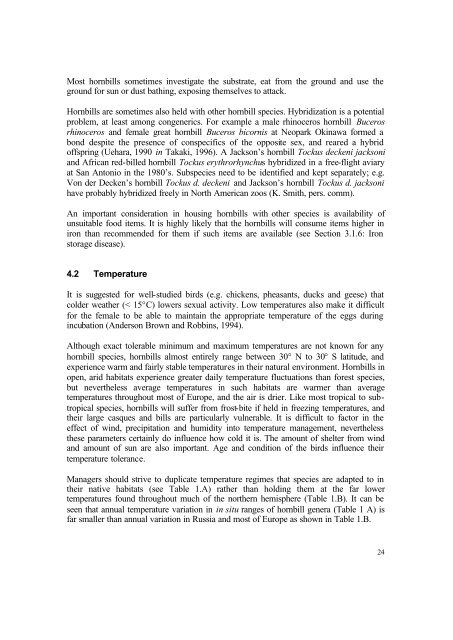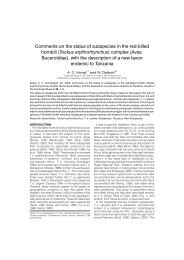EAZA Hornbill Management and Husbandry Guidelines
EAZA Hornbill Management and Husbandry Guidelines
EAZA Hornbill Management and Husbandry Guidelines
You also want an ePaper? Increase the reach of your titles
YUMPU automatically turns print PDFs into web optimized ePapers that Google loves.
Most hornbills sometimes investigate the substrate, eat from the ground <strong>and</strong> use the<br />
ground for sun or dust bathing, exposing themselves to attack.<br />
<strong>Hornbill</strong>s are sometimes also held with other hornbill species. Hybridization is a potential<br />
problem, at least among congenerics. For example a male rhinoceros hornbill Buceros<br />
rhinoceros <strong>and</strong> female great hornbill Buceros bicornis at Neopark Okinawa formed a<br />
bond despite the presence of conspecifics of the opposite sex, <strong>and</strong> reared a hybrid<br />
offspring (Uehara, 1990 in Takaki, 1996). A Jackson’s hornbill Tockus deckeni jacksoni<br />
<strong>and</strong> African red-billed hornbill Tockus erythrorhynchus hybridized in a free-flight aviary<br />
at San Antonio in the 1980’s. Subspecies need to be identified <strong>and</strong> kept separately; e.g.<br />
Von der Decken’s hornbill Tockus d. deckeni <strong>and</strong> Jackson’s hornbill Tockus d. jacksoni<br />
have probably hybridized freely in North American zoos (K. Smith, pers. comm).<br />
An important consideration in housing hornbills with other species is availability of<br />
unsuitable food items. It is highly likely that the hornbills will consume items higher in<br />
iron than recommended for them if such items are available (see Section 3.1.6: Iron<br />
storage disease).<br />
4.2 Temperature<br />
It is suggested for well-studied birds (e.g. chickens, pheasants, ducks <strong>and</strong> geese) that<br />
colder weather (< 15°C) lowers sexual activity. Low temperatures also make it difficult<br />
for the female to be able to maintain the appropriate temperature of the eggs during<br />
incubation (Anderson Brown <strong>and</strong> Robbins, 1994).<br />
Although exact tolerable minimum <strong>and</strong> maximum temperatures are not known for any<br />
hornbill species, hornbills almost entirely range between 30° N to 30° S latitude, <strong>and</strong><br />
experience warm <strong>and</strong> fairly stable temperatures in their natural environment. <strong>Hornbill</strong>s in<br />
open, arid habitats experience greater daily temperature fluctuations than forest species,<br />
but nevertheless average temperatures in such habitats are warmer than average<br />
temperatures throughout most of Europe, <strong>and</strong> the air is drier. Like most tropical to subtropical<br />
species, hornbills will suffer from frost-bite if held in freezing temperatures, <strong>and</strong><br />
their large casques <strong>and</strong> bills are particularly vulnerable. It is difficult to factor in the<br />
effect of wind, precipitation <strong>and</strong> humidity into temperature management, nevertheless<br />
these parameters certainly do influence how cold it is. The amount of shelter from wind<br />
<strong>and</strong> amount of sun are also important. Age <strong>and</strong> condition of the birds influence their<br />
temperature tolerance.<br />
Managers should strive to duplicate temperature regimes that species are adapted to in<br />
their native habitats (see Table 1.A) rather than holding them at the far lower<br />
temperatures found throughout much of the northern hemisphere (Table 1.B). It can be<br />
seen that annual temperature variation in in situ ranges of hornbill genera (Table 1 A) is<br />
far smaller than annual variation in Russia <strong>and</strong> most of Europe as shown in Table 1.B.<br />
24




